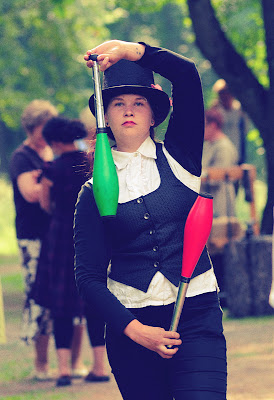* in fact, I believe the problem is often more acute with professional photographers, because somewhere along the way they might have lost their personal, inspired approach to photography and treat clients like simple units/subjects (or, worse, as moving/talking wallets filled with cash)
The present article is not, however, about this highly important element (but worry not, I promise to refer to it at some point in a future article!). Instead, today I will share with you 5 technical details that will help you with your portrait photos. Like with so many other things, nobody taught me these, I never found them anywhere online, and I had to discover them myself, through experience. And now I want to share them with you!
1. Watch out for reflections on eyeglasses
I'm not talking about reflections of things (or even the photographer him/herself) on people's glasses. I'm talking about light reflections. Especially with flash photography, it is very easy to get highlights that are impossible or impractical to correct. If you're shooting photos of a person wearing glasses, use as big a reflector as you can (a side wall will do fine), and examine the photo carefully right after. If you can't eliminate the highlights no matter how reflected your flash light is, consider natural light. A slightly different angle might also be helpful
 |
| Prime lenses usually have little or no distortion. Taken with an AF Nikkor 180mm f/2.8 |
2. Stiff expressions
Few things are more catastrophic for a successful result than stiff/unnatural expressions. It's not the person's fault - some people are just shy or uncomfortable when photographed. It's your job as a photographer to go around this. I won't go into the human factor here (like promised, this is material for a future article), but here's a quick technical trick: Use a remote release (ideally, an IR-based, as it is more discreet). Have the camera set and ready, and talk to the person. When they're getting ready - but aren't posing yet - simply release the shutter. Another idea that sometimes might work, is to ask them to close their eyes for a moment, then open them. In the split second after they do, take the photo.
3. Color cast due to nearby fabrics
The human eye (or our brain, more like) has a remarkable ability to filter out "inconsistencies" of all kinds. We get the impression of even color, even exposure, even depth of field. In reality, our brains simply process the signals so fast that it's an illusion of continuity. A camera, just like the human capturing device (the eye that is!), reveals these inconsistencies.
If you are taking a photograph in a space where there are colored fabrics near the person you are photographing, be careful. Depending on the flash positioning, direction, and exposure, as much as the proximity of the fabric, there might be enough colored reflection off the fabric to create an unnatural color cast on part of the person's face. Imagine a situation with a red curtain on the person's left side. If enough flash output is reflected off that, the left cheek will look significantly more red than the right!
4. Lens Distortion
That is a very common discussion issue, and yet few people really understand what's involved. Worse still, some people believe they can "fix it on Photoshop". That is a huge misconception. Not everything can be fixed like that.
There are several kinds of distortion. There's barrel distortion - typical with wide angle lenses; there's pincushion distortion - at the long end of zoom teles; there's complex distortion (wave-like, very difficult to get rid of completely); there's the perspective distortion (typical with some ultra-wides). And so on...
Of course, the ideal scenario is that you wouldn't have any kind of distortion. Some lenses are practically distortion-free (such as my beloved AF 50mm f/1.8). If you use a lens that isn't distortion free, you should still know of its distortion characteristics and take them into consideration.
Generally:
- avoid wide-angle; if you shoot group shots and it's possible, use a normal lens and take a few steps back.
- if you can't avoid wide angle, keep people away from the corners of the frame. That's where the distortion is the most prominent
- if your lens has plenty of barrel distortion (such as, sadly, the AF-S 35mm f/1.8), don't shoot too close to the person, and avoid "mugshot"-type shots (you should avoid those in any case, actually). Have them sit or stand a bit sideways and look at the camera.
- pincushion is less perceivable than barrel, but it's still better to avoid the long end of teles for portraits. If you're using an 80-200mm lens, opt for a focal length of 105-150mm
5. Depth of field for editing considerations
If you plan to do some creative post-processing on a portrait photo (say, exchange the background) your job will be infinitely easier if you make sure you create a clear contrast between the person (and especially their hair) and the background. The obvious thing to do - and what you might have heard before - is to have a white background for dark-haired people and a dark background for fair-haired people.
But what you probably haven't read about anywhere is this: Keep the person fully in focus and throw the background out of focus. The background has to be positioned a bit further back from the person in order to achieve this. If part of the person's hair is out of focus, you will suffer a lot during post-production! Every last hair must be sharp, while the background is a creamy, even blur.


No comments:
Post a Comment